Renesas RA4M1 ARM MCU容性触摸和LCD控制方案
 123
123
 拍明
拍明
原标题:Renesas RA4M1 ARM MCU容性触摸和LCD控制方案
Renesas公司的RA4M1是采用高性能Arm® Cortex®-M4核的微控制器(mcu)系列产品,提供分段LCD控制器和容性触摸检测单元.MCU集成了多个软件和引脚兼容的Arm®32位核,提供低功耗,高性能Arm Cortex®-M4核,工作频率48MHz,集成了256KB闪存,32KB SRAM,分段LCD控制器(SLCDC),容性触摸检测单元(CTSU),USB 2.0全速模块(USBFS),14位ADC(ADC14)和12位DAC(DAC12),8位DAC(DAC8)x2,低功耗模拟比较器(ACMPLP)x2,运算放大器(OPAMP)x4以及温度传感器(TSN).具有加密AES128/256和GHASH以及真随机号码发生器(TRNG).工作温度-40℃ 到 +85℃和-40℃到 +105℃.中电网为您整理如下详细资料,主要用在密集的人机界面设计如容性触摸通路和分段LCD控制器.本文介绍了RA4M1主要特性,框图,以及评估板EK-RA4M1 v1主要特性,框图,电路图,材料清单和PCB设计图.
The Renesas RA4M1 group of micrcontrollers (MCUs) uses the high-performance Arm® Cortex®-M4 core and offers a segment LCD controller and a capacitive touch sensing unit input for intensive HMI designs. The RA4M1 MCU is built on a highly efficient low power process and is supported by an open and flexible ecosystem concept—the Flexible Software Package (FSP), built on FreeRTOS—and is expandable to use other RTOSes and middleware. The RA4M1 is suitable for applications where a large amount of capacitive touch channels and a segment LCD controller are required.
The MCU integrates multiple series of software- and pin-compatible Arm®-based 32-bit cores that share a common setof Renesas peripherals to facilitate design scalability and efficient platform-based product development.
The MCU provides an optimal combination of low-power, high-performance Arm Cortex®-M4 core running up to48 MHz with the following features:
256-KB code flash memory
32-KB SRAM
Segment LCD Controller (SLCDC)
Capacitive Touch Sensing Unit (CTSU)
USB 2.0 Full-Speed Module (USBFS)
14-bit A/D Converter (ADC14)
12-bit D/A Converter (DAC12)
Security features.
RA4M1主要特性:
■ Arm Cortex-M4 Core with Floating Point Unit (FPU)
Armv7E-M architecture with DSP instruction set
Maximum operating frequency: 48 MHz
Support for 4-GB address space
Arm Memory Protection Unit (Arm MPU) with 8 regions
Debug and Trace: ITM, DWT, FPB, TPIU, ETB
CoreSight™ Debug Port: JTAG-DP and SW-DP
■ Memory
256-KB code flash memory
8-KB data flash memory (100,000 program/erase (P/E) cycles)
32-KB SRAM
Flash Cache (FCACHE)
Memory Protection Unit (MPU)
128-bit unique ID
■ Connectivity
USB 2.0 Full-Speed Module (USBFS)
- On-chip transceiver with voltage regulator
- Compliant with USB Battery Charging Specification 1.2
Serial Communications Interface (SCI) × 4
- UART
- Simple IIC
- Simple SPI
Serial Peripheral Interface (SPI) × 2
I2C bus interface (IIC) × 2
Controller Area Network (CAN) module
Serial Sound Interface Enhanced (SSIE)
■ Analog
14-bit A/D Converter (ADC14)
12-bit D/A Converter (DAC12)
8-bit D/A Converter (DAC8) ×2 (for ACMPLP)
Low-Power Analog Comparator (ACMPLP) × 2
Operational Amplifier (OPAMP) × 4
Temperature Sensor (TSN)
■ Timers
General PWM Timer 32-Bit (GPT32) × 2
General PWM Timer 16-Bit (GPT16) × 6
Asynchronous General-Purpose Timer (AGT) × 2
Watchdog Timer (WDT)
■ Safety
Error Correction Code (ECC) in SRAM
SRAM parity error check
Flash area protection
ADC self-diagnosis function
Clock Frequency Accuracy Measurement Circuit (CAC)
Cyclic Redundancy Check (CRC) calculator
Data Operation Circuit (DOC)
Port Output Enable for GPT (POEG)
Independent Watchdog Timer (IWDT)
GPIO readback level detection
Register write protection
Main oscillator stop detection
Illegal memory access
■ System and Power Management
Low power modes
Realtime Clock (RTC) with calendar and Battery Backup support
Event Link Controller (ELC)
DMA Controller (DMAC) × 4
Data Transfer Controller (DTC)
Key Interrupt Function (KINT)
Power-on reset
Low Voltage Detection (LVD) with voltage settings
■ Security and Encryption
AES128/256
GHASH
True Random Number Generator (TRNG)
■ Human Machine Interface (HMI)
Segment LCD Controller (SLCDC)
- Up to 38 segments × 4 commons
- Up to 34 segments × 8 commons
Capacitive Touch Sensing Unit (CTSU)
■ Multiple Clock Sources
Main clock oscillator (MOSC)
(1 to 20 MHz when VCC = 2.4 to 5.5 V)
(1 to 8 MHz when VCC = 1.8 to 2.4 V)
(1 to 4 MHz when VCC = 1.6 to 1.8 V)
Sub-clock oscillator (SOSC) (32.768 kHz)
High-speed on-chip oscillator (HOCO)
(24, 32, 48, 64 MHz when VCC = 2.4 to 5.5 V)
(24, 32, 48 MHz when VCC = 1.8 to 5.5 V)
(24, 32 MHz when VCC = 1.6 to 5.5 V)
Middle-speed on-chip oscillator (MOCO) (8 MHz)
Low-speed on-chip oscillator (LOCO) (32.768 kHz)
IWDT-dedicated on-chip oscillator (15 kHz)
Clock trim function for HOCO/MOCO/LOCO
Clock out support
■ General Purpose I/O Ports
Up to 84 input/output pins
- Up to 3 CMOS input
- Up to 81 CMOS input/output
- Up to 9 input/output 5-V tolerant
- Up to 2 high current (20 mA)
■ Operating Voltage
VCC: 1.6 to 5.5 V
■ Operating Temperature and Packages
Ta = -40℃ to +85℃
- 100-pin LGA (7 mm × 7 mm, 0.65 mm pitch)
Ta = -40℃ to +105℃
- 100-pin LQFP (14 mm × 14 mm, 0.5 mm pitch)
- 64-pin LQFP (10 mm × 10 mm, 0.5 mm pitch)
- 64-pin QFN (8 mm × 8 mm, 0.4 mm pitch)
- 48-pin LQFP (7 mm × 7 mm, 0.5 mm pitch)
- 48-pin QFN (7 mm × 7 mm, 0.5 mm pitch)
- 40-pin QFN (6 mm × 6 mm, 0.5 mm pitch)
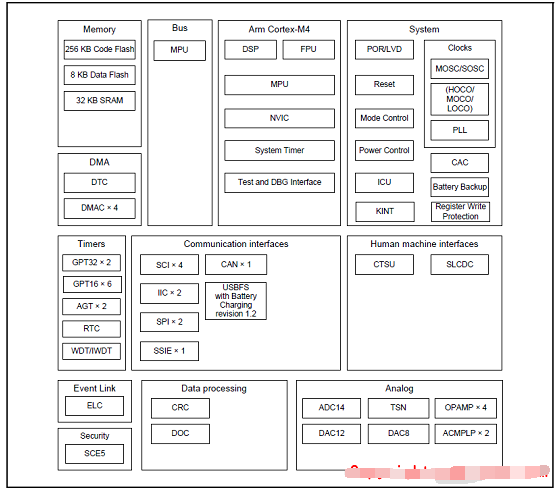
图1.RA4M1框图
评估板EK-RA4M1 v1
Evaluation Kit for RA4M1 Microcontroller Group EK-RA4M1 v1
The EK-RA4M1 v1 enables developers to get started with initial firmware development.
• Renesas RA4M1 Microcontroller Group
R7FA4M1AB3CFP
100-pin LQFP package
48 MHz Arm® Cortex®-M4 core with Floating Point Unit (FPU)
32 KB SRAM
256 KB code flash memory
8 KB data flash memory
• Connectivity
A Device USB connector for the Main MCU
SEGGER J-Link® On-Board (OB) interface for debugging and programming of the RA4M1 MCU. A 10pin JTAG/SWD interface is also provided for connecting optional external debuggers and programmers.
Two PMOD connectors, allowing use of appropriate PMOD compliant peripheral plug-in modules for rapid prototyping
Pin headers for access to power and signals for the Main MCU
• Multiple clock sources
Main MCU oscillator crystals, providing precision 12.000 MHz and 32,768 Hz external reference clocks
Additional low-precision clocks are available internal to the Main MCU
• MCU reset push-button switch
• MCU boot configuration jumper
• General purpose I/O ports
One jumper to allow measuring of Main MCU current
Copper jumpers on PCB bottom side for configuration and access to selected MCU signals
• Operating voltage
External 5 V input through the Debug USB connector supplies the on-board power regulator to power the Evaluation Kit logic and interfaces. External 5 V or 3.3 V may also be supplied through alternate locations on the Evaluation Kit.
• A two-color board status LED indicating availability of regulated power and connection status of the J-Link interface
• A red User LED, controlled by the Main MCU firmware
• A User Push-Button switch, User Capacitive Touch Sensor (button), and an optional User Potentiometer, all of which are controlled by the Main MCU firmware.
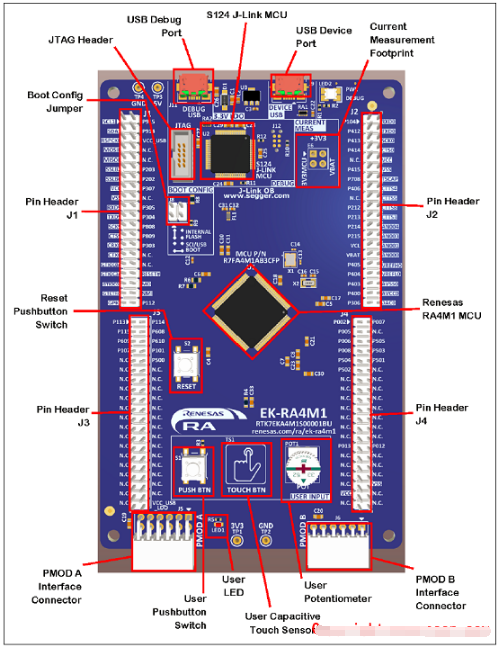
图2.评估板EK-RA4M1 v1外形图(正面)
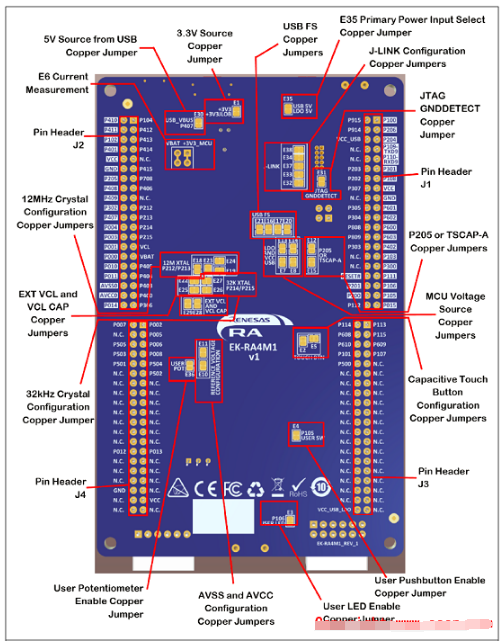
图3.评估板EK-RA4M1 v1外形图(背面)
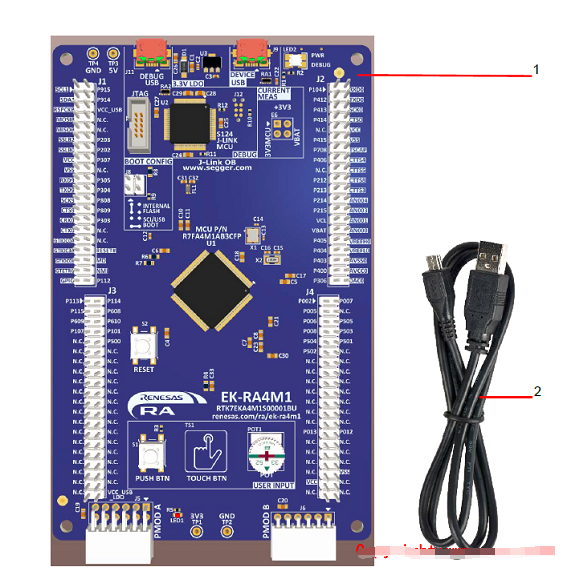
图4.评估板EK-RA4M1 v1套件图
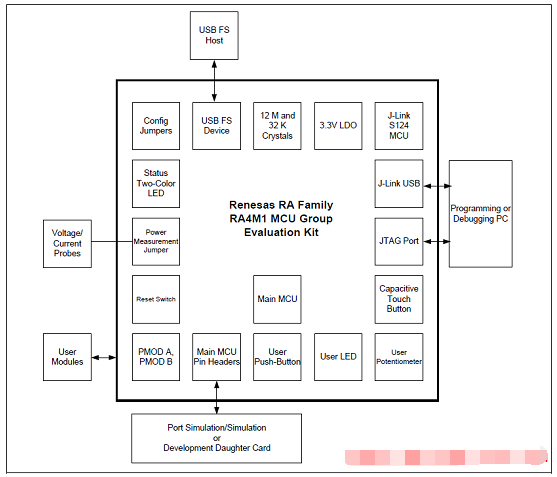
图5.评估板EK-RA4M1 v1框图
责任编辑:David
【免责声明】
1、本文内容、数据、图表等来源于网络引用或其他公开资料,版权归属原作者、原发表出处。若版权所有方对本文的引用持有异议,请联系拍明芯城(marketing@iczoom.com),本方将及时处理。
2、本文的引用仅供读者交流学习使用,不涉及商业目的。
3、本文内容仅代表作者观点,拍明芯城不对内容的准确性、可靠性或完整性提供明示或暗示的保证。读者阅读本文后做出的决定或行为,是基于自主意愿和独立判断做出的,请读者明确相关结果。
4、如需转载本方拥有版权的文章,请联系拍明芯城(marketing@iczoom.com)注明“转载原因”。未经允许私自转载拍明芯城将保留追究其法律责任的权利。
拍明芯城拥有对此声明的最终解释权。




 产品分类
产品分类















 2012- 2022 拍明芯城ICZOOM.com 版权所有 客服热线:400-693-8369 (9:00-18:00)
2012- 2022 拍明芯城ICZOOM.com 版权所有 客服热线:400-693-8369 (9:00-18:00)


